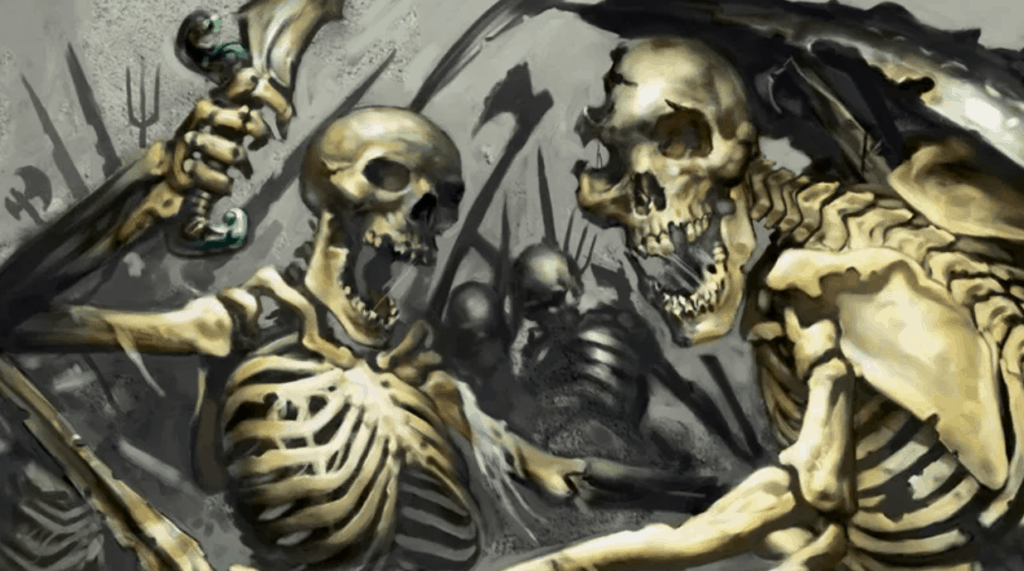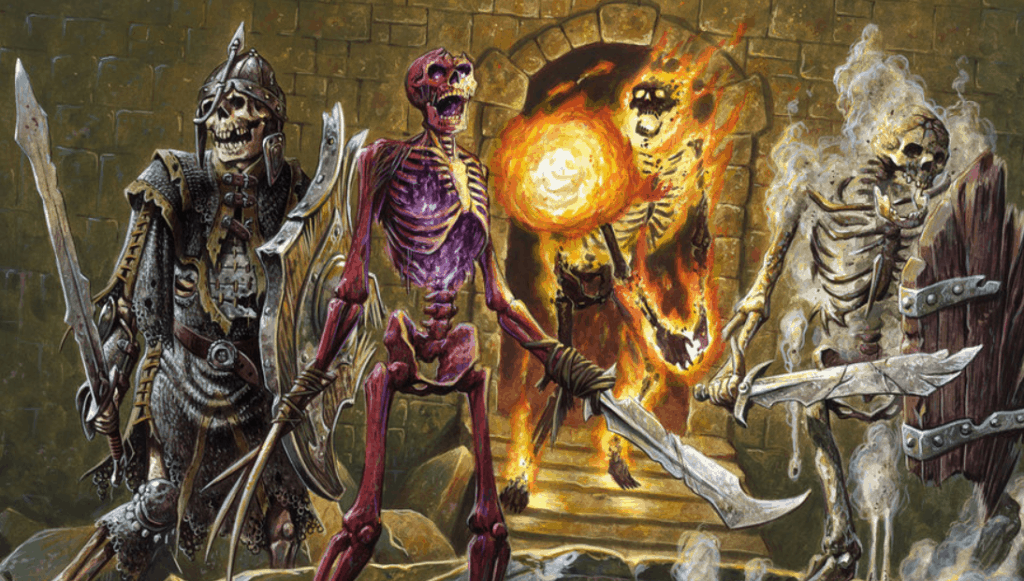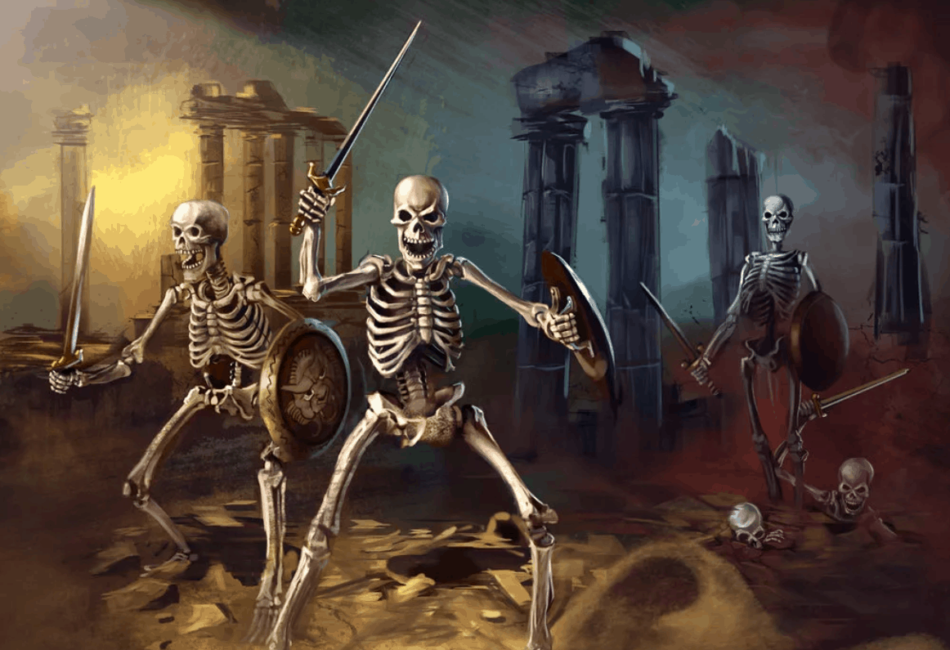The humble skeleton is a staple in any 5e campaign. It is one of the oldest monsters in both DnD and the lore of the real-life world. No wonder, because all of us are walking skeletons, and it is often all that remains of us years after we have passed. It is more than deserving to have its own skeleton 5e guide.
This makes for some pretty rich lore and possibilities for any Dungeon master who wants to add some more spooky skeleton vibes to the story. For players too, the skeleton has a rich variety of possibilities and not just as a mob monster. More and more players are playing Homebrew classes, and a skeleton-based class is one of the more popular picks.
In this beginner 5e guide I am going to discuss:
- Skeleton as a DnD monster, and how a dungeon master can make the most use of it.
- Skeleton as a Homebrew player character and the possibilities, advantages, and disadvantages this class has.
Using skeletons as a monster in 5e DnD

What exactly is a skeleton in Dungeons and Dragons?
Skeletons in the broadest meaning of the word are the remains of humans and animals animated by dark necromancy magic. They are animated dead that have regained a form of vitality by magic. This magic assembles their bones and whatever else remains of the human or animal and gives it the energy needed to execute movements.
In general, a skeleton has no memories of the past, however, the resurrection of a skeleton can restore the soul and some primal emotions that come with it. The skeleton that is reanimated – if done by a magic caster at least – is completely obedient to their master. They follow the orders given to them without hesitation and without any free will or much creative thinking.
They take their commands literally. Which can form quite a problem when the caster can not give any new orders and a new challenge or complexity occurs. This doesn’t mean they can’t follow complex orders. As long as their instructions are clear, they can do quite a lot of things that are asked of them.
Why do skeletons behave so weird

While they are reanimated and lack the intelligence they once had in life, that doesn’t mean they can’t figure stuff out. They won’t start smashing against a door when they can just open it by using the handle. They also have a thing called habitual behaviors. These occur when the skeleton is free or temporary without any control of the caster.
This habitual behavior will make them do things they did in their former life. A skeleton who was a farmer might start raking the fields, and a woodcutter might try to chop a tree when he has an axe. The same occurs for the skeletons of creatures and animals.
One of these habitual behaviors is that they instinctively attack anything that is alive. This is due to the necromantic power that dwells within them that gives them a sort of urge to kill without morals and fear. Unless their summoner or master commands them to not attack they will fight until they are destroyed. This makes them a great ´living´ trap in dungeons. They don’t require any food, air, water, and rest and can lay dormant until they detect something which is alive.
How do you use a skeleton as a Dungeon Master

Let’s first flip to page 272 in the monster manual for 5e DnD. There we can find all the stats we need for our skeleton. They are medium-sized monsters and are undead. More importantly, their armor class is 13, and they have 13 hit points or 2d8 +4 if you want to make it a bit more random.
This is what this all means if you break it down:
- Undead – Obviously, a skeleton is an undead monster. This means that all spells or abilities that affect undead affect skeletons. If a Paladin uses a Divine Smite spell it will deal extra damage in 5e.
- Armor and hit points – The armor and hit points of a skeleton isn’t all that special. Both of the stats are 13, so your party should not have too much trouble dealing with one. However, if you come across them in a group they are pretty powerful and dangerous to fight if you don’t have a cleric or a paladin.
These are the rest of the stats they have according to the monster manual.
- Constitution: 15 (+2)
- Intelligence: 6 (-2)
- Strength: 10 (+0)
- Dexterity: 14 (+2)
- Wisdom: 8 (-1)
- Charisma: 5 (-3)
So how can you use skeleton’s stats to the fullest and make sure your players don’t walk all over them?
Players with good wisdom save spells are going to wreak havoc on your skeletons, due to the very low wisdom stat of 8 (-1). The skeletons shine if they have to do a constitution or dexterity saving throw. So if your players rely on spells that for example have a dex save, they are going to have quite a hard time.
Vulnerabilities, immunities, and senses of skeletons
Skeletons don’t have resistance, but they do have interesting vulnerabilities and immunities that you can use to take them out or make them stronger.
Vulnerability – Our bone fiend is weak to bludgeoning damage. They take double the damage when they get it with a weapon that deals with that kind of output. So these are clubs, hammers, Warhammer, and so on.
Immune – One of the immunities a skeleton has is against poison damage, so no matter how much poison damage your attack has, it does exactly zero to skeletons. Moreover, a skeleton also has immunity against poisoned conditions. The second immunity a skeleton has is against exhaustion, so no matter what they do they can´t get exhausted.
A good Dungeon master should be able to use these immunities to their fullest. For example, you can put poison gas traps all over the place and your skeleton horde won’t feel a thing.
Some extra info before we get to the actions skeletons have in 5e DND, we need to discuss some minor details that might be relevant for DMs who love to pay attention to the little things to make an engaging story.
Skeletons also have dark vision up to 60 ft. Which is quite far in the D&D world. Their passive perception is decent at 9. Lastly, if they knew any language in their past life, they will still understand it. Lacking vocal cords, they will not be able to speak it. They also lack the intelligence – most of the time – to be able to use written communication.
Skeleton’s actions and how to use them
This reanimated pile of bones only has 2 kinds of actions. The first is a short sword attack, and the other is an action where they use a short bow. I do not agree with this. As a Dungeon Master, it is better to make your monsters more realistic. This means giving your skeletons the ability to dodge an attack, disengage from combat (if they have a master nearby), or grapple players.
There also is no reason why you would not give a skeleton a different weapon than those two. Skeletons can follow commands, so having them use for example a hammer is no problem. The same goes for magical items and armor. If your skeletons have a master, and he is pretty well off, nothing stops him from giving his skeletons better armor and weapons.
Skeletons are almost always in groups, so make sure you have a nice mix of weapons and abilities they can use. Try to give the party maximum trouble, being smart with your surroundings. As said, the skeletons are immune to poison, most player characters are not. There is little reason for masters of skeletons not to use poison traps if they want to keep out all life forms from whatever place they are guarding.
You will need a bit of creativity to use skeletons to their maximum potential and make sure they are more than a boring mob for your players to put through the meat- uhhh bone grinder. Keep in mind that a skeleton is a very broad group of creatures. Almost every single vertebrate can be turned into a skeleton, from a mouse to a dragon.
Using a skeleton class as a player

Playing as a skeleton as a player is pretty fun! You can find quite a few tips online on how to make it more fun and not a pain for your Dungeon Master.
As a skeleton, you are undead, and this comes with quite a lot of interesting perks. You don’t get sick or poisoned, you have no need for food and no need for sleeping. This means you save quite a lot of money in the inn! It is advised that there is a sort of sleep-like state to make this not too overpowered. Something like a mandatory rest period of 2 to 6 hours is what I would advise.
If you want, you can make your body disconnectable. Since your bones are held together by magic, you can remove and attach them. I would make it have a small cost to make it a bit more realistic.
It does sound like there should be some damage or a drawback to breaking this magic bond between separate bones and joints. However, this is completely up to your DM. Otherwise, you would become a mean, lean dodging machine. Whenever you would be about to get hit, you could disconnect your bones to take less damage. That does sound a bit too overpowered to me.
So, one of the hardest things to decide as a player is how intelligent you are as a skeleton. Of course, you can have your skeleton level-up in consciousness as it gets stronger, or make the skeleton some kind of abnormality that has retained most if not all of his intelligence.
I do love the concept of the skeleton having average intelligence compared to other skeletons for the beginning of the game. This means doing stupid skeleton stuff like attacking living things if you are not given the order not to, and being generally evil.
If your party is playing as the good guys, it might be a good idea to give them the power to control you with direct orders. If you are good at plot progression and story building as a player, you can have the skeleton slowly retain self-awareness and intelligence as you get stronger.
If you need some more tips on playing as a skeleton, make sure you use your dark vision well. You can see 60 feet of dim light as if it was bright, so this is a pretty cool perk if your group does a lot of dungeons. Also, something a lot of players forget, skeletons can not speak if they are basic skeletons. An alternative for this would be to have magic vibrate sounds that seem like speech, or to do your communication with written words. You will need the intelligence to do so.
If a player is playing as a mute skeleton, a fun idea would be to have an item hidden away somewhere that can steal the voice of a target.
All in all, playing as a skeleton is a lot of fun! If you are able to follow the rules of being undead and all the disadvantages and advantages that come with that fact, it will make sure that your campaign and game is unique.
Frequently Asked Questions
Question: Can I damage a skeleton with a spell or attack with necrotic damage?
Answer: Yes, in 5e DnD you can damage and kill a skeleton with necrotic damage. Despite being undead they do not have a resistance nor are they immune to this kind of damage. They do have immunity against poison.
Question: Are there attacks that work better on skeletons?
Answer: Yes, there are a couple of attacks that are more effective on skeletons. First, there are certain spells like a Clerics Turn Undead and the Divine Smite of a Paladin. Second, there are certain weapons that deal double damage to a skeleton. There are weapons that can bludgeon, an example of this is a club or a Warhammer.
Question: Is it possible to charm a skeleton, or are they immune?
You can charm a skeleton. They are not immune, however, make sure you read the text of your charm skill. There might be something that says it does not work on the undead.
Skeleton 5e Guide: Conclusion
Skeletons are one of the most basic monsters in DnD and you are going to run into them pretty often in the beginning of the game. Depending on how creative your DM is, they can be a lot of fun to fight and pose quite a challenge when they are in a group and are equipped with some special weapons and items.
Playing as a skeleton as a player character is great. It is one of the most fun Homebrew classes I have ever played. The main challenge when playing as a skeleton is keeping in mind that you are a bunch of walking animated bones. People are going to be pretty surprised seeing you walk around in the open.
- Monks 5e Guide: How to Play as a Monk in D&D - September 13, 2021
- DnD Hobgoblin Guide [Creatures and Playable Race] - September 9, 2021
- The Ultimate DnD Yklwa 5e Guide: Everything You Need to Know - September 5, 2021

